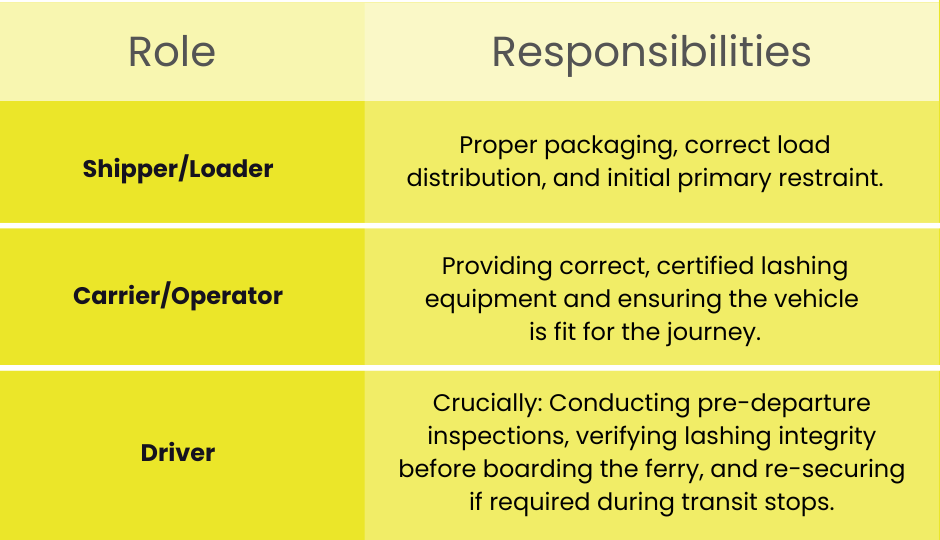
In the fast-paced world of freight transport, securing your booking with the right ferry route is just the first step. The second, and arguably most critical is securing your cargo.
On the road, improper securing leads to accidents. On a ferry, particularly when navigating the unpredictable waters, that risk is magnified. Rough seas and seasonal bad weather conditions introduce pitching, rolling and motion that exerts extreme forces far beyond typical road driving, This turns improperly secured cargo into a hazard that threatens safety, can causes severe damage and lead to costly delays.
As your dedicated freight ferry ticket agent, Freightlink gets you the best rates and routes across Europe. Don't risk fines or load refusal at the port due to an unstable load that won't withstand a storm.
The regulatory framework: Stay ahead of port inspections
Every driver must operate within the EU's established legal standards:
- Directive 2014/47/EU: This mandates strict roadside and port inspections focused on load securing. If non-compliant, your vehicle can be immobilised, causing costly delays to your schedule and your client's supply chain.
- EU Best Practice Guidelines (2014): Widely adopted across Member States, these serve as the industry gold standard for securing methods.
- EN 12195-1 Standard: This is the technical reference for all calculations, providing formulas for lashing forces and the correct use of securing devices. Inspectors frequently reference this.
Shared responsibility: Whose job is the load?
Securing a load is a collective duty, especially when a ferry crossing adds extra variables to the journey.

Remember, your drivers must also have load securing principles integrated into their training under Directive 2003/59/EC (CPC).
Requirements for ferry-ready cargo
Cargo securing must prevent movement in all directions—forward, backward, laterally, and vertically. On a ferry, this is vital as the vessel's movement adds another dynamic force.
✅ Positioning & Distribution
Cargo must be stably placed to prevent movement even during emergency braking or cornering. Balanced weight distribution is critical for both road safety and vehicle stability during the ship's movement.
✅ Securing Equipment
Use only equipment that is certified and in good condition:
- Webbing straps and chains
- Load bars and internal blockers
- Anti-slip mats and corner protectors
Always use anti-slip mats and edge protection. They dramatically increase the friction component of your securing strategy and protect your valuable straps from wear.
Find out more about how to secure your cargo on our Securing Vehicles & Cargo on Ferries Guide page
✅ Calculation Requirements (EN 12195-1)
Lashing force calculations must meet resistance standards that simulate severe manoeuvring:
- 0.8g forward (braking)
- 0.5g sideways (cornering)
You must use anchorage points on the vehicle that are rated to handle the calculated load forces.
Special Load Considerations Before Boarding
Abnormal Loads
These are subject to Directive 96/53/EC. Freightlink can help you navigate the specific requirements for abnormal loads, but the vehicle compliance and securing remain your responsibility.
Dangerous Goods (ADR)
For any bookings with goods classed as ''Hazardous'' (even those listed as 'Limited Quantities'), operators must be notified in advance under the IMDG (International Maritime Dangerous Goods) Code. All hazardous shipments will require a Dangerous Goods Note detailing the UN number, Class and Packing Group of the product.
Practical Guidance for Your Drivers & Operations Team
To avoid costly delays and ensure safe passage on your booked routes:
- Train Frequently: Ensure your team's training covers both the theory and the practical, hands-on skills of lashing and blocking.
- Use Checklists: Implement mandatory pre-departure checklists—specifically for securing devices and load stability—before arriving at the port gate.
- Maintain Equipment: Regularly inspect and immediately replace strained or damaged straps, chains, and anti-slip mats. Port inspectors will check this!
- Document Everything: Keep clear records of load plans, calculations, and training logs to present during compliance audits.
🚢 Smooth Sailing Starts with Secure Cargo
At Freightlink, we pride ourselves on delivering a seamless booking experience for thousands of routes across Europe, the Irish Sea, and the Channel. We know that the difference between an on-time delivery and a costly delay often comes down to the basics: a secure load.
By rigorously applying the principles of Directive 2014/47/EU and EN 12195-1, you protect your drivers, your goods, and your reputation.
Need to book your next European crossing or a complex freight route?
Get in touch with our dedicated account managers today. We'll help you find the most efficient and cost-effective ferry and tunnel routes to keep your compliant fleet moving across borders.




 United Kingdom
United Kingdom Republic of Ireland
Republic of Ireland Polska
Polska România
România Republica Moldova
Republica Moldova Российская Федерация
Российская Федерация Украина
Украина Республика Беларусь
Республика Беларусь Литва
Литва Латвия
Латвия Эстония
Эстония Deutschland
Deutschland Schweiz
Schweiz Österreich
Österreich Lichtenstein
Lichtenstein Belgien
Belgien Luxemburg
Luxemburg Magyarország
Magyarország Česká republika
Česká republika Slovenská republika.
Slovenská republika. España
España Italia
Italia Bulgaria
Bulgaria








